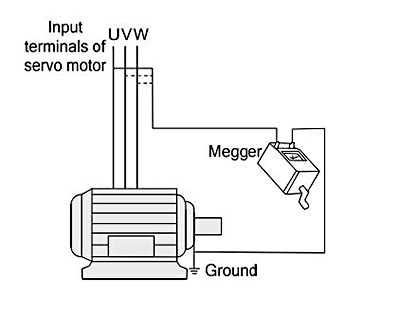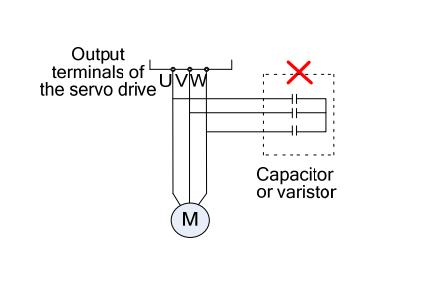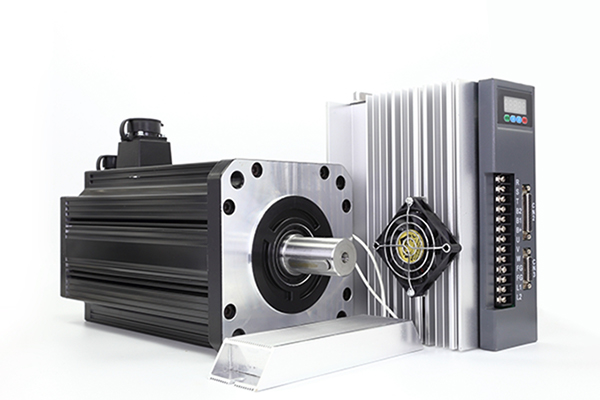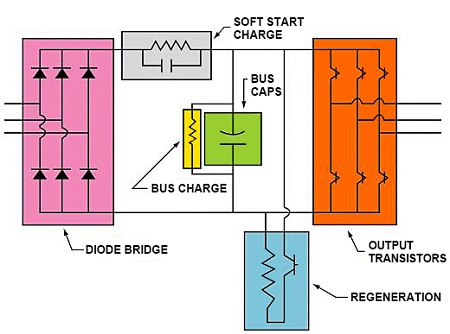Home » Servo Drive » 10 Tips for Using Servo Drive
10 Tips for Using Servo Drive
Safety precautions are essential when working with servo drives to ensure the well-being of personnel and the proper functioning of equipment. Here are some general safety precautions to consider.
-
Servo motor insulation test. Perform the insulation test when the servo motor is used for the first time, reused after being stored for a long time, or in a regular checkup, in order to prevent poor insulation of servo motor windings from damaging the servo drive. The servo motor must be disconnected from the servo drive during the insulation test. A 500-V mega-Ohm meter is recommended for the test. Ensure that the insulation resistance is not less than 5 MΩ.

- Thermal protection of motor. If the rated capacity of the motor selected does not match that of the servo drive, especially when the rated power of the servo drive is greater than that of the motor, adjust the motor protection parameters on the operation panel of the servo drive or install a thermal relay for the motor for protection.
- Motor heat and noise. The output of the servo drive is pulse width modulation (PWM) wave with certain harmonics, and therefore, the temperature rise, noise, and vibration are slightly greater than those at running with the mains frequency.
- Voltage-sensitive device or capacitor on the output side of the servo drive. The output of the AC drive is PWM wave. Do not install the capacitor for improving power factor or lightning protection voltage-sensitive resistor on the output side of AC drive. Otherwise, the AC drive may suffer transient overcurrent or even be damaged.
- Use outside the rated voltage. The servo drive must not be used outside the allowable voltage range specified in this manual. Otherwise, components inside the servo drive may be damaged. If required, use a corresponding voltage step-up or step-down device. Do not change three-phase input of the servo drive into two-phase input because this will cause faults or damage to the servo drive.
-
Surge suppressor. The servo drive has a built-in varistor for suppressing the surge voltage generated when the inductive loads (electromagnetic contactor, electromagnetic relay, solenoid valve, electromagnetic coil and electromagnetic brake) around the servo drive are switched on or off. If the inductive loads generate a very high surge voltage, use a surge suppressor for the inductive load or use a surge suppressor together with a diode. Do not connect the surge suppressor on the output side of the servo drive.

- Altitude and de-rating. In places where the altitude is above 1000 m, the cooling effect reduces due to thin air, and it is necessary to de-rate the servo drive. Contact the agent or Inovance for technical support.
- Special usage. If wiring that is not described in this manual such as common DC bus is applied, contact the agent or Inovance for technical support.
- Disposal. The electrolytic capacitors on the main circuits and PCB may explode when they are burnt. Poisonous gas is generated when the plastic parts are burnt. Treat them as ordinary industrial waste.
- Adaptable motor. The standard adaptable motor is permanent synchronous servo motor. The standard parameters of the adaptable motor have been configured inside the servo drive. It is still necessary to perform motor auto-tuning or modify the default values based on actual conditions. Otherwise, the running effect and protection performance will be affected. The servo drive may alarm or even be damaged when short-circuit exists on cables or inside the motor. Therefore, perform the insulation short-circuit test when the motor and cables are newly installed or during routine maintenance. During the test, make sure that the servo drive is completely disconnected from the testing parts.
Post a Comment:
You may also like:

Category
Featured Articles
What are the Soft Start Techniques for ...
 Servos (as commonly used in radio-controlled vehicles and small-scale robotics)are DC actuators that use a potentiometer to ...
Servos (as commonly used in radio-controlled vehicles and small-scale robotics)are DC actuators that use a potentiometer to ...
 Servos (as commonly used in radio-controlled vehicles and small-scale robotics)are DC actuators that use a potentiometer to ...
Servos (as commonly used in radio-controlled vehicles and small-scale robotics)are DC actuators that use a potentiometer to ...Servo Drive System vs. Variable ...
 A servo drive system, as opposed to a variable frequency drive (VFD) or AC motor drive , has the ability to position with ...
A servo drive system, as opposed to a variable frequency drive (VFD) or AC motor drive , has the ability to position with ...
 A servo drive system, as opposed to a variable frequency drive (VFD) or AC motor drive , has the ability to position with ...
A servo drive system, as opposed to a variable frequency drive (VFD) or AC motor drive , has the ability to position with ...How to Install a Servo Drive?
 Installing a servo drive involves several steps, and the specific process may vary depending on the manufacturer and model of the ...
Installing a servo drive involves several steps, and the specific process may vary depending on the manufacturer and model of the ...
 Installing a servo drive involves several steps, and the specific process may vary depending on the manufacturer and model of the ...
Installing a servo drive involves several steps, and the specific process may vary depending on the manufacturer and model of the ...What are the Basics of Servo Drive?
 Servo motors come in so many types and flavors that it is difficult to define them in a way that is accurate and universally ...
Servo motors come in so many types and flavors that it is difficult to define them in a way that is accurate and universally ...
 Servo motors come in so many types and flavors that it is difficult to define them in a way that is accurate and universally ...
Servo motors come in so many types and flavors that it is difficult to define them in a way that is accurate and universally ...